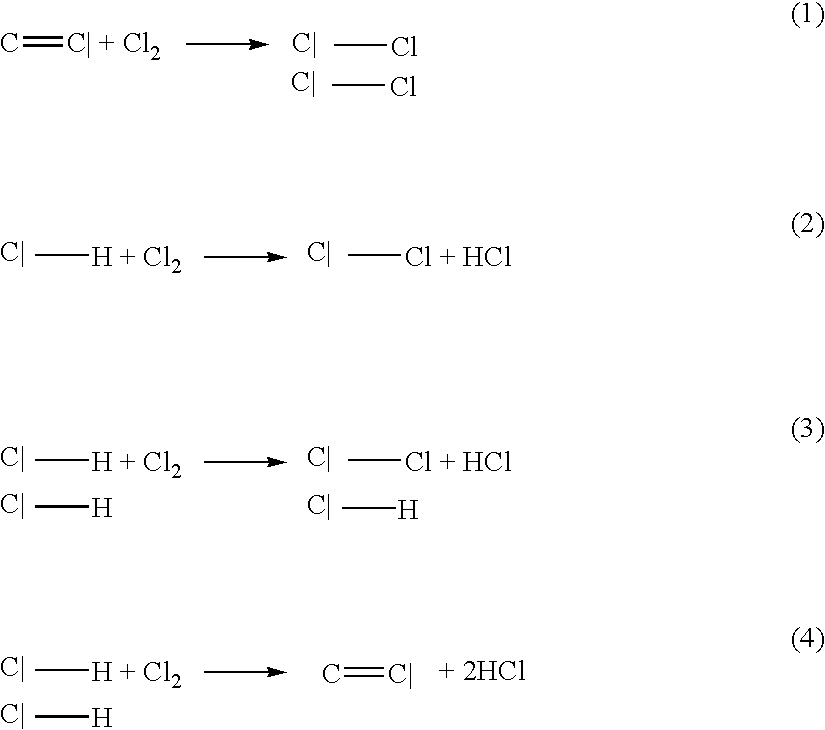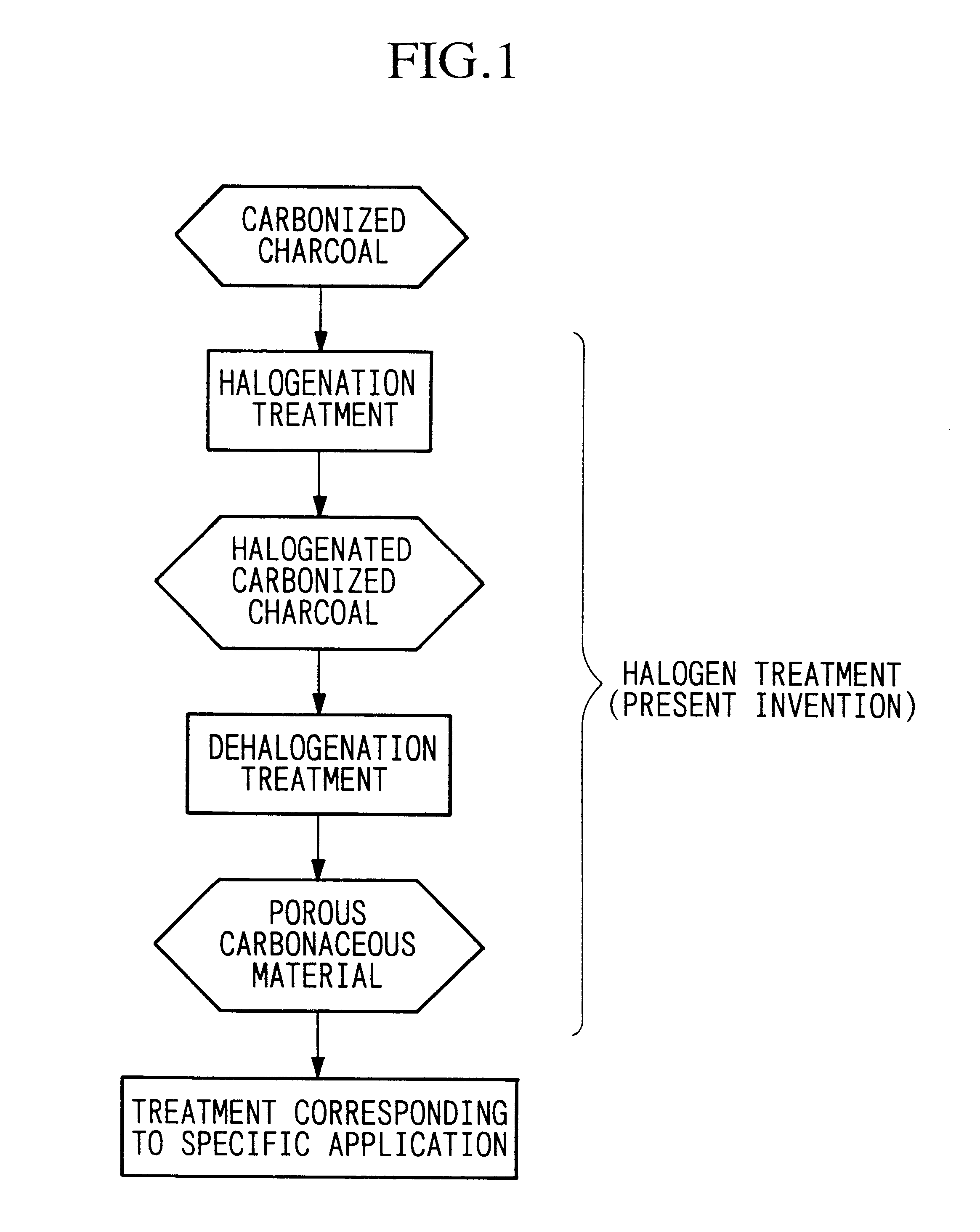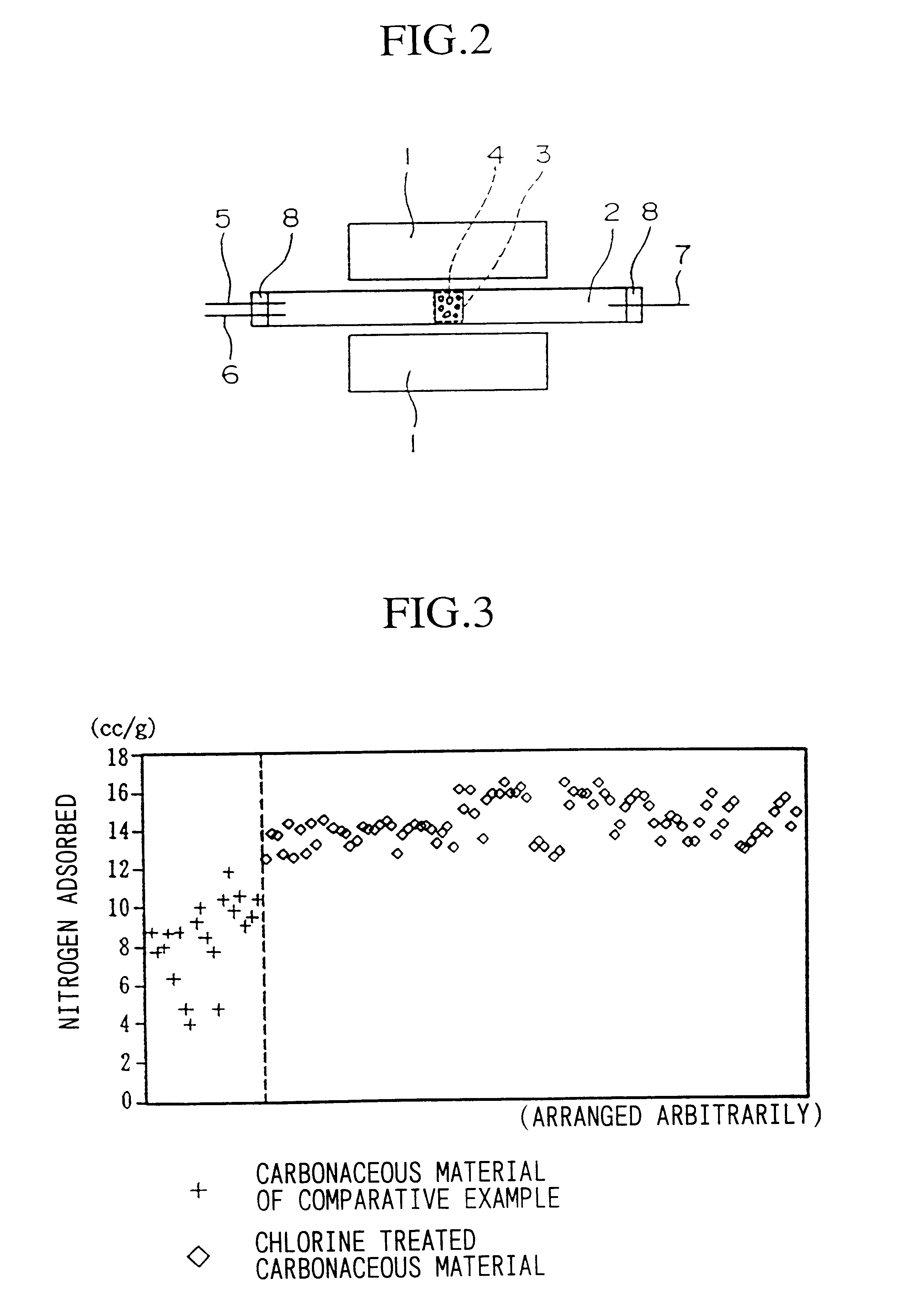Porous carbonaceous material, manufacturing method therefor and use thereof
a carbonaceous material and manufacturing method technology, applied in the field of porous carbonaceous materials, can solve the problems of insufficient adsorption capacity, inability to establish this as a general theory, and inability to form pores of uniform pore diameter, etc., and achieves easy dissociation, high adsorption strength, and easy incorporation into the carbon net structure
- Summary
- Abstract
- Description
- Claims
- Application Information
AI Technical Summary
Benefits of technology
Problems solved by technology
Method used
Image
Examples
example 1
A / B, High Temperature Dechlorination / In Nitrogen Gas
Carbonized Charcoal A (1) (15 g) and Carbonized Charcoal B (2) (15 g) were each chlorinated (60 minutes) by heating to a temperature of 500.degree. C., and running a gas mixture of 0.1 L / min chlorine in 0.9 L / min nitrogen over them. Next, specimens (1) and (2) were dechlorinated (high temperature dechlorination treatment) by heat-treating at 1000.degree. C. for 60 minutes under a nitrogen gas flow (3 L / min). During the dechlorination treatment, the presence of hydrogen chloride in the nitrogen exhaust gas was confirmed by means of a detector tube (models 14L and 14M manufactured by Gastech (Ltd)). The weights after the dechlorination treatment had decreased, respectively, (1) -5.8% by weight, and (2) -4.3% by weight, (the "-" sign before the numbers indicates the decrease in weight based on the carbonized charcoal; this is the same hereinafter). The amount of nitrogen adsorbed was (1): 12.6 cc / g, and (2): 13.9 cc / g.
The amount of ni...
example 2
B, High Temperature Dechlorination / In a Vacuum
Carbonized Charcoal B (10g) was chlorinated (60 minutes) by heating to a temperature of 550.degree. C., and running a gas mixture of 0.1 L / min chlorine in 0.9 L / min nitrogen over it. Next, it was dechlorinated by connecting a vacuum pump to the exhaust gas outlet line of the chlorine treatment apparatus, and conducting a heat-treatment at a temperature of 1000.degree. C. during vacuum evacuation. The vacuum at the inlet mouth of the vacuum pump was 10 Torr. The amount of nitrogen adsorbed was 13.8 cc / g.
In the same way as in nitrogen, and even for heat treatment (high temperature dechlorination treatment) under vacuum evacuation, the amount of nitrogen adsorbed increased.
example 3
B, High Temperature Dechlorination, Effect of Amount of Carbonized Charcoal on Chlorination and Effect of Temperature on Heat Treatment in Nitrogen
Two specimens (each 10 g) of Carbonized Charcoal B taken as starting material were respectively chlorinated (60 minutes) by heating to a temperature of 550.degree. C., and running a gas mixture of 0.1 L / min chlorine in 0.9 L / min nitrogen over them. Next, under a nitrogen gas flow (3 L / min), each of the two specimens were dechlorinated by heat-treating for 30 minutes at a temperature of 700.degree. C. for (1), and 900.degree. C. for (2). In the same way, two specimens (each 25 g) of Carbonized Charcoal B taken as starting material were respectively chlorinated (60 minutes) by heating to a temperature of 550.degree. C., and running a gas mixture of 0.1 L / min chlorine in 0.9 L / min nitrogen over them. Next, under a nitrogen gas flow (3 L / min), each of the two specimens were dechlorinated by heat-treating at a temperature of 700.degree. C. for...
PUM
| Property | Measurement | Unit |
|---|---|---|
| temperature | aaaaa | aaaaa |
| temperature | aaaaa | aaaaa |
| temperature | aaaaa | aaaaa |
Abstract
Description
Claims
Application Information
 Login to View More
Login to View More - R&D
- Intellectual Property
- Life Sciences
- Materials
- Tech Scout
- Unparalleled Data Quality
- Higher Quality Content
- 60% Fewer Hallucinations
Browse by: Latest US Patents, China's latest patents, Technical Efficacy Thesaurus, Application Domain, Technology Topic, Popular Technical Reports.
© 2025 PatSnap. All rights reserved.Legal|Privacy policy|Modern Slavery Act Transparency Statement|Sitemap|About US| Contact US: help@patsnap.com



